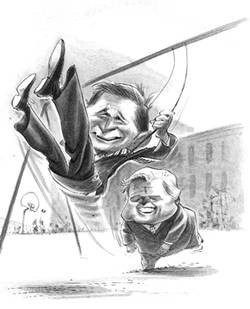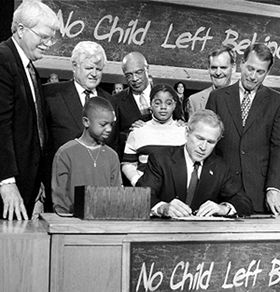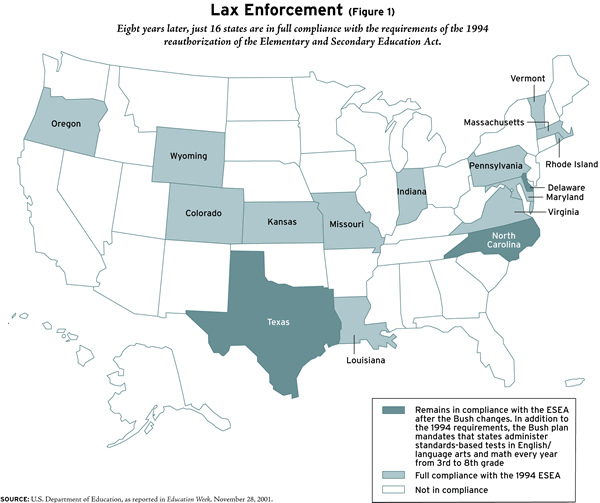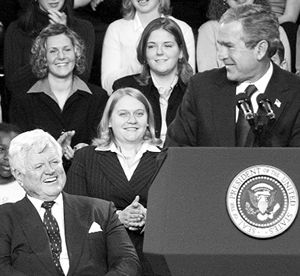 |
| Illustration by Dan Vasconcellos
|
Amid a throng of cheering teenagers in the Hamilton High School gymnasium, President Bush declared victory. “Today begins a new era, a new time in public education in our country,” he intoned confidently into the microphone. “As of this hour, America’s schools will be on a new path of reform, and a new path of results.” With that, he signed into law the bill that reflected much of his education agenda. This Ohio school was the first stop of the two-day tour the president and his merry band of liberal and conservative lawmakers took in January to celebrate the president’s first true bipartisan triumph.
But the party’s a bit premature. To be sure, the president gets credit for forging a consensus after years of ideological and political gridlock. And the law does make some significant changes in federal education policy. Nevertheless, the reauthorized Elementary and Secondary Education Act (ESEA) hardly represents a new era. Instead, it builds on at least a decade’s worth of federal reform efforts. Where the Bush administration could make its mark is in its enforcement of the law, an area in which few, if any, previous administrations have found the political will to play rough with the states.
The law calls for annual tests in reading and math for children in grades 3 through 8, plus a science test in three different grade levels by the 2007-08 school year. (States were already required to test students once in high school.) States must also establish a definition of a failing school that meets federal guidelines. Schools labeled failing for two or more years face increasingly stringent penalties, which states must impose. The law also leaves a host of issues unresolved, giving the states and the federal Department of Education plenty of wiggle room. Thus the quality of implementation may vary widely.
The federal government sports a sobering track record when it comes to enforcing its education reforms. President Clinton’s 1994 ESEA reauthorization was hailed by proponents as “the most extensive revision of the legislation since [its enactment in] 1965.” It required the states to develop standards and assessments linked to the standards. But lawmakers like Representative George Miller, D-Cal., say the changes envisioned by the 1994 reauthorization didn’t live up to their billing because “its implementation was fudged by the administration.”
Lawmakers in both parties hope that this time a combination of tough federal sanctions, more public reporting of student performance, and an aggressive White House will be enough to prompt change in the schoolhouse. “This bill delivers the goals and the tools to achieve them,” says Miller, one of the four top congressional negotiators on the bill. Still, he says, “The bill is not a silver bullet.”
 |
| Lawmakers in both parties hope that this time a combination of tough federal sanctions, more public reporting of student performance, and an aggressive White House will be enough to prompt change in the schoolhouse.
|
A Long and Winding Road
President Clinton kicked off the ESEA debate in May 1999, when he submitted his proposal to reauthorize the law, which was due to expire that year. But Congress continued arguing about the proposal into 2000, and it was shelved in the din of the presidential election. With the two candidates running even in the polls, neither party wanted to risk passing a bill when there was a good chance that they could send a bill that was more to their guy’s liking the next year. Furthermore, education would be a less potent issue on the campaign trail if Congress passed a major education reform bill.
Once elected, President Bush sent the early message that he wanted an education bill, and he wanted it to be a bipartisan one. Before his inauguration, Bush held a bipartisan education meeting in Austin, and among the hand-picked Democrats attending was Sen. Evan Bayh, D-Ind. Bayh and Sen. Joseph I. Lieberman, D-Conn., had put forth an education reform bill in early 2000 called the Three R’s, aimed at bridging the partisan divide in education.
Borrowing liberally from Lieberman and Bayh’s reform package, Bush said that the 54 federal elementary and secondary education programs should be consolidated into five categories reflecting federal priorities: 1) educating disadvantaged students; 2) teacher quality; 3) English fluency; 4) school choice; and 5) school safety. Bush also proposed that states begin testing children in grades 3 through 8. He wanted to allow children in schools that failed to close the achievement gap for three straight years to use federal money to attend private schools. On his second full day in office, Bush unveiled an education “blueprint” that was essentially the same as his campaign proposal. The White House immediately began negotiating with the 10 centrist Democrats cosponsoring the Lieberman-Bayh bill, which they reintroduced the day Bush unveiled his proposal, in an effort to cut a deal quickly.
However, when it became clear by the spring that Bush’s tax cut would pass with the help of a few centrist Democrats, the Lieberman-Bayh group became leery of ditching their party a second time. The White House had also begun negotiating with Sen. Edward M. Kennedy, D-Mass., and the centrist Democrats feared that the White House would play the centrist and liberal Democrats against one another. For instance, the White House got Kennedy to agree to a limited voucher to pay for tutoring services. It then took that agreement to the New Democrats, who had been holding out on a voucher compromise, to try to get the New Democrats to incorporate the tutoring proposal into the deal they were negotiating separately with the White House. To avoid this, Lieberman decided that future negotiations would have to include Kennedy.
A new negotiating group formed, this time including the White House, Republicans, New Democrats, and Kennedy sympathizers. After a month of negotiations, the group reached agreement on the two most controversial issues: vouchers and block grants. They went with Kennedy’s voucher compromise, which allowed students in failing schools to use federal money for private tutoring. They also agreed to a scaled-back block-grant proposal that would have allowed 7 states and 25 school districts to sign a performance contract with the federal government that would free them of most federal education regulations in exchange for a promise to improve student performance. They thought they had a bill ready to send to the Senate floor.
But at a late-night meeting in mid-April, one congressional aide announced that 80 to 90 percent of the schools in states like Texas and North Carolina, both of which had seen rising achievement scores through the 1990s, would be deemed “failing” under the bill’s definition. The bill required states to set performance goals for every demographic group of students. The problem was that if a school didn’t meet that goal for any one group in any grade level in any one year, it would be labeled failing.
Two weeks later, the senators settled on a complicated formula that required states to calculate an overall performance grade for a school based on several factors, including improving test scores for poor and minority children. But no longer could a school receive a failing grade solely because its poor and minority students didn’t see their test scores rise. By the time this definition was devised, it was early May. The Senate began debate, but it dragged on for six weeks as the Senate juggled campaign finance reform and turned over to Democratic control.
On the House side, the bill moved more quickly. A series of bipartisan negotiations between Reps. Miller and John Boehner, R-Ohio, chairman of the House Committee on Education and the Workforce, produced a bill that was similar to the Senate’s, but without the block-grant provisions. The Republican leadership and a handful of rank-and-file conservatives protested. But President Bush weighed in on Boehner and Miller’s side, and the House passed the bill on May 23. The Senate passed its version a few weeks later.
Still, little was settled on the accountability front. The Senate’s rejiggered formula was widely seen as too complicated for parents to understand, and the House’s formula would run into the same reality-check problems that the Senate’s had before it was revised. The conference committee charged with resolving differences between the House and Senate versions of the bill began meeting in late July, but the bill languished in committee as the members squabbled over details small and large.
In the meantime, fears over the shrinking surplus were beginning to dominate debate on Capitol Hill. Democrats charged that Bush’s tax cut made it impossible to fund education adequately. Interest groups concerned with some of the testing and accountability requirements began circling.
“There weren’t a lot of bipartisan feelings,” remembers Bush education adviser Sandy Kress. “[Bush] was concerned. . . . The momentum clearly had slowed. He was aware of the mood and the difficulties when we came back from the August recess. We were supposed to be farther along.”
Then September 11 intervened. When he first heard of the terrorist attacks on the World Trade Center and the Pentagon, Bush was visiting a Florida elementary school to publicly prod Congress to send him a final bill. Perversely enough, the attacks probably helped get the process back on track by ending the political bickering, congressional aides said. The negotiations were kicked up to the conference’s top four members: Reps. Miller and Boehner and Sens. Kennedy and Judd Gregg, R-N.H. The thorniest issue-the definition of a failing school-was resolved by the Big Four by late September.
Under the new definition, states must design a plan to raise the children in several demographic groups-black, white, Hispanic, poor, and disabled-to a “proficient” level of achievement on state tests within 12 years. States determine what a proficient score will be and choose an initial goal for the percentage of students in each group that will attain a proficient grade that year. They must raise that bar over time, so that each state reaches 100 percent proficiency 12 years later. If a school does not meet the performance goal for one demographic group, but reduces the number of children who are not proficient by 10 percent, the school will avoid federal penalties. Schools that don’t meet either goal will be labeled failing.
While congressional negotiators had agreed to this compromise in September, they didn’t announce it until the final conference bill was set in order to avoid opening it up to too much criticism from interest groups and others (as had happened in August) and jeopardizing other negotiations in progress. “We kept it quiet for a long time,” said one lawmaker involved in the negotiations process. “It was the most sensitive part of the bill.”

Following in Dad’s Footsteps
The new testing requirement exemplifies Bush’s tough-love approach to education reform. “I understand taking tests aren’t [sic] fun,” the self-proclaimed C student at Yale University told the crowd at Hamilton High. “Too bad.” One of the least debated provisions, the requirement for annual testing, is probably the biggest change in the 2002 law. Though the numbers vary depending on how you read the new law, 15 states currently meet the annual testing requirement in math, 17 in reading, and 24 have established a science test, according to the Education Commission of the States.
This is not, however, a sea change in federal policy. Annual testing builds on the efforts initiated by the Clinton administration in 1994, which in turn built on ideas put forth by President George H. W. Bush when he convened the state governors at the first National Education Summit in 1989. “It’s a continuation of an era,” said John F. “Jack” Jennings, director of the Center on Education Policy and a longtime Democratic aide on the House education committee.
In 1994, Congress began requiring states to establish academic standards in each grade and to create tests to assess whether children have learned the material. Those tests had to be administered to all poor children at least once in grades 3 through 5, 6 through 9, and 10 through 12. Clinton’s 1999 proposal would have expanded that testing to all students. The new law mandates that all students take tests that measure their progress against state standards every year in grades 3 through 8.
The bill Bush signed also requires that the National Assessment of Educational Progress (NAEP) be given in every state every other year in math and reading, but the results cannot influence whether a school is designated as failing. Initially, Bush had proposed that NAEP be administered every year as a national barometer for the state tests. Currently, NAEP is administered in those subjects every four years in about 40 states, a number that fluctuates from test to test depending on which states decline to participate.
The 1994 legislation only suggested penalties for schools that failed to improve student test scores, but Clinton’s 1999 proposal, which never made it into law, would have required that states intervene in perpetually failing schools. “The Bush administration took the Clinton administration’s ideas and ran with them,” said one bemused Democratic congressional aide who worked at the Department of Education under Clinton.
The new law sets out a timeline of increasingly severe sanctions to nudge recalcitrant schools along. If a school fails to meet annual state test-score goals for two years, students can transfer to another public school in the district. The failing school also receives extra money to revamp academic programs. After three years of failure, the district must use 5 percent of the money it receives for poor children under the federal Title I program’s “Basic Grants” section to pay for outside tutoring services. After four failing years, a school must make significant structural changes, such as revamping the curriculum or firing staff, and may be eligible for a state takeover the following year. At no point does a state or school lose money if it continues producing poor results, although districts eventually have to divert federal money to pay for tutoring services.
Building on the work of one’s predecessors can produce success stories. That’s just what Bush did as governor of Texas. His reforms expanded those of former governor Ann Richards, whose reforms built on those in places like Dallas and previous statewide efforts led by, of all people, Ross Perot. Dallas, it happens, is where then-school board president Sandy Kress initiated accountability-using standardized tests to reward and sanction schools. “This is our theme,” Kress said. “We may not know a lot of music in Texas, but we can sing the song we know well.”
 |
| The new testing requirement exemplifies President Bush’s tough-love approach to education reform. This is not, however, a sea change in federal policy. Annual testing builds on the efforts initiated by the Clinton administration in 1994.
|
A New Enforcement Era?
The Bush administration tried to set a new tone the night after the president signed the education bill, when Secretary of Education Rod Paige invited 30 state education chiefs to Mount Vernon to discuss the new law and his expectations for the states. After dining on pork and pumpkin mousse, Paige made his pitch: The old days of waivers and delays and closing our eyes to enforcement problems are over.
Analysts say the tough-love message is a good one, but that backing it up will be difficult. “Everybody jumps on this wagon and says we’re really going to be tough,” said Marshall S. Smith, the acting deputy secretary of education in the Clinton administration. “That’s macho talk. That’s not going to work in the real world of kids and schools.”
So far, only 16 states have complied with the requirements of the 1994 law. The Bush administration’s first task will be to get the other 34 states into compliance. Then, they’ll have to review the new statewide plans for getting every child in every demographic group to a “proficient” level of achievement within 12 years. After the states have set their yearly performance goals, the Department of Education will have to monitor the performance of the nation’s 92,000 public schools to see whether each demographic group in each grade being tested is meeting the state performance goals.
The law also leaves open a number of questions, mostly surrounding the quality of the reforms states undertake. One of the most significant ambiguities is whether states can develop an annual testing system by piecing together state and district tests given in different grade levels. Some critics worry that states will create systems where a student’s results on a district test one year cannot be compared with results on a state test the next year. “There’s going to be a lot of discussion about that,” Kress said. “There’s no easy answer right now.”
Others worry that with 50 different statewide tests, the federal government will lack a meaningful tool with which to compare test scores across state lines. “What happened was you had a whole bunch of folks who wanted standards but not standardization,” said Arnold Fege, president of Public Advocacy for Kids, a nonprofit public education advocacy group. “As a result, we’ve got 49 different states with 49 different standards and 49 different testing systems. The question is what does it all mean? You can’t compare the states.” (The number is only 49 because Iowa declined to create statewide academic standards per the 1994 law’s requirements.)
For many of the testing quality issues, the federal government is taking a hands-off approach. “Our job will not be to pass judgment on the quality of state standards or the quality of the assessments based on those standards,” said Undersecretary Eugene Hickok, the Department of Education’s point person on enforcement.
The department’s approach to enforcement is largely preventative. Hickok is setting up an implementation team in Washington that will be bolstered by staff members in the department’s regional offices. The team will assemble an analysis of where states are in the reform process, and it will be updated as states make additional changes. Meanwhile, top department officials will reach out to state officials to encourage them to comply. “Our goal is to respond as quickly as possible, and not just to say yes or no, but to help them achieve it,” Hickok said.
Some states and schools are likely to test how serious the administration is about enforcement. “There are going to be a lot of schools that take a wait and see attitude with compliance,” said David Shreve, senior committee director for the National Conference of State Legislatures. “I think there will be a great number of states and systems that will say,-Let’s do as much as we can without breaking our backs,’ knowing full well that the bill will be up for a new reauthorization before any of these really bad consequences kick in.”
States are also now facing budget deficits-at least in the near term. Some liberal members of Congress, like Sens. Paul Wellstone, D-Minn., and James M. Jeffords, I-Vt., even voted against the bill because they view the funding level as insufficient to help the reforms really take hold. Jeffords called the bill “counterproductive, if not destructive.” Even Miller, who advocated accountability before it was cool, worries about states’ being able to pay to fix the problems the test scores highlight. “It comes in a down economy, and we worry the states are going to be forced to make cuts that will challenge the success of this bill,” he said. Just a month after Bush signed the education bill, with Miller and Kennedy at his side, the two Democrats held a press conference to denounce Bush’s 2003 education budget, which they say falls way short of what’s needed to fulfill the mandates of the new education law.
To a large degree, says Hickok, the key to enforcement will be parents. He hopes that parents of children in failing schools, armed with information about how their schools and children are doing, will force schools to offer them the options that are laid out in the federal law. Having been there and done that in Washington, Marshall Smith agrees. “The only way you’re really going to get accountability-accountability at the point where politicians really feel the pressure-is bad press,” he said. But, he says, the statistics the federal government is requiring schools to report offer parents no useful information about what their children do and don’t know.
The first test of the Bush administration’s enforcement chops will come in handling the schools that are already on the Department of Education’s list of failing schools. Students in schools that have been on the list for three or more years, estimated to be at least 3,000, should now be entitled to tutoring services, and students in at least 6,500 should earn the option to transfer to another public school.
Once the statewide accountability systems are in place, enforcement will get increasingly difficult as states are required to raise the goals for student achievement no less than every three years. As more and more schools face sanctions, how will the administration handle the inevitable logistical and political quicksand? What happens if all the high-performing schools in a district are full and can’t take the children who were granted public school choice because their own school failed two years in a row? “We’ve had a lot of discussion about it,” Hickok said. “The law does not impose the Department of Education into the state to make sure they’re doing public school choice the way we want to or supplemental services the way we want to.” In fact, Hickok isn’t even sure what the federal government can do if students in a failing school can’t transfer to another public school in the district because there’s no room at the better schools.
Sustaining the momentum on enforcement may be the administration’s biggest challenge. “Paige is saying he won’t give any waivers. Now we shall see. I hope that he can keep the pressure on,” says Jack Jennings of the Center on Education Policy. “Elections come up. Is Bush going to deny [New York] Gov. [George] Pataki federal aid when he’s running for reelection, if the state has not met its testing requirements?” (Money can be withheld from a state for not complying with the requirements of the law, but not for poor results.)
Even with a troubled economy and continuing worries about terrorism, education remains a high-level concern among voters. Bush’s education record will no doubt play an important role in the next election. That means the person who will ultimately be held most accountable in the eyes of the public for reforming the schools is President Bush.
-Siobhan Gorman covers education for National Journal.


